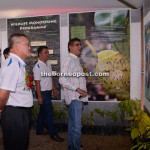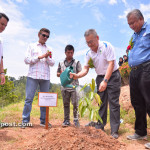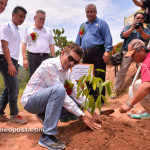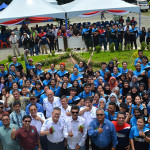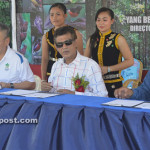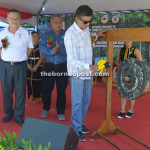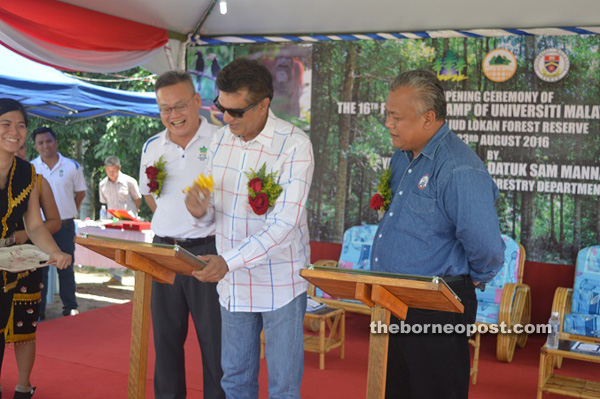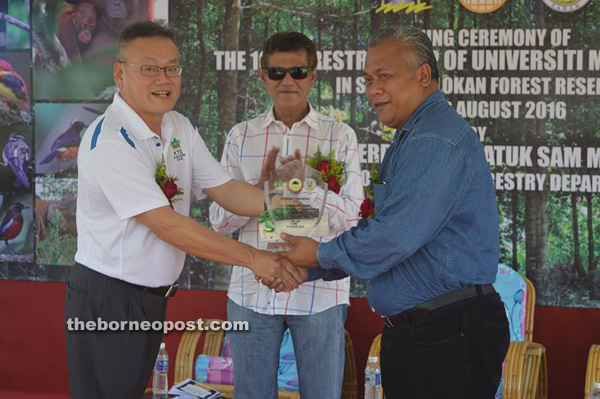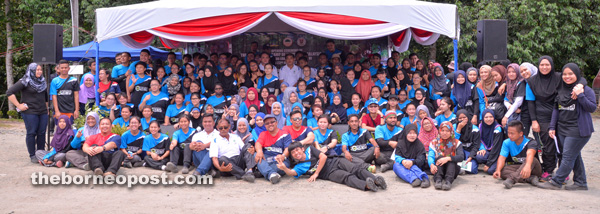- (From left) Shahril, Law and Sam (at right) visit an exhibition booth.
- Law pouring water to a tree he had planted during the ceremony.
- Sam Mannan planting a tree at the ceremony.
- Sharil, Law and Sam (front, middle) with invited guests, lecturers and students in front of KTS Plantation Sdn Bhd office at Segaliud Lokan Forest Reserve
- (From right) Shahril, Sam Mannan and Law signing the extension of LOI.
- Sam Mannan beating the gong to mark the opening of 16th Forest Camp at Segaliud Lokan Forest Reserve.
SANDAKAN: The 16th Universiti Malaysia Sabah (UMS) Forestry Camp was launched on Tuesday at KTS Plantation Sdn Bhd (KTS) in Segaliud Lokan Forest Reserve (SLFR) Forest Management Unit (FMU) 19B.
It marked another milestone for Sabah’s forest industry with an innovative collaboration between the Sabah Forestry Department (SFD), UMS and KTS.
The collaboration is the first to have three main industry players join forces to develop a comprehensive, long-term collaboration to promote and enhance the Sustainable Forest Management (SFM) agenda.
A Letter of Intent (LOI) – which prepares the parties for a memorandum of understanding (MoU) in strengthening and developing long-term research, training and academic partnerships in Sabah forestry – was signed by SFD director Datuk Sam Mannan, UMS’ Prof Dr Sharil Yusof and KTS Holdings director Law Hui Kong.
The High Conservation Value Forest (HCVF) initiative was also launched with Nephentes ampularia and Toluh Waterfall declared as formal HCVF sites.
Segaliud Lokan Forest Reserve (SLFR), which is managed by KTS was selected as the site for the 16th Forestry Camp based on its reputation as a role model of SFM by a private company in Sabah over the past 15 years.
Well-managed forest management enterprise
The SLFR models owes its success to proper planning, concept development and implementation of the Forest Management Plan, which serves as a guiding principle to plan ahead and operationalise the annual work plan.
The objectives are to manage the forest in a way that mimics natural processes for production of low volume, high quality and high priced timber.
“KTS Plantation is considered a model for the rest of the industry players when it comes to SFM. Due to its relentless commitment, perseverance, adaptability to change, pragmatic flexibility and investing in good forest governance, KTS managed to emerge as the first private company in Malaysia to be certified with both the Malaysian Timber Certification Scheme (MTCS) and MS ISO 14001 EMS,” Sam said in his speech.
KTS would therefore be an ideal model to represent forest management enterprises in Sabah as a case study for forestry students to better understand the implementation of SFM.
Forest operations
Sam explained that SLFR and much of the surrounding area were virgin forest until the 1950s, when the reserve was logged several times like much of the lowland dipterocarp forest in Sabah.
It constitutes a typical example of logged forests and is, consequently, an ideal site for developing a model for improved forest management.
In 1993, KTS was granted the licence to manage SLFR and in 1998 KTS voluntarily entered into an agreement with SFD to manage the concession area based on SFM principles, marking the first FMU to implement the Reduced Impact Logging (RIL) concept in its Industrial Tree Planting (ITP) areas.
“Together with its neighbour, the Deramakot Forest Reserve, which form part of the FMU19, SLFR is a testimony of the tangible long-term benefits of a successful SFM implementation, which is only possible with serious commitment of the top management of KTS,” Sam said.
He commended KTS Group of Companies managing director Dato Henry Lau for embracing SFM voluntarily and becoming the pioneer among private enterprise in SFM implementation in Sabah.
KTS has actively carried out the forest rehabilitation programme since 2000.
To date, over one million seedlings of various fast growing high value timber species have been planted on a cumulative area of about 4,000ha.
Other forest silviculture treatment such as climber cutting has been carried out on more than 20,000ha.
Conservation of flora and fauna
SLFR is one of the few areas that has the highest diversity and concentration of Rare, Threatened and Endangered (RTE) species in Sabah.
It is home to at least 75 species of mammals including Borneo pygmy elephants, orangutan and tembadau, as well as over 220 species of birds.
Through its well-formulated FMP, a comprehensive conservative approach has been employed in its operations to mitigate the impact of management activities.
As planned in the FMP, approximately three-quarters of SLFR remain undisturbed or closed to forest management activities at any given time.
This means all forest management activities (silviculture, enrichment planting, and harvesting) are focused on a small portion (2,500 ha) of the SLFR staggered over a period of 10 years, which translates to a management cycle of about 20 years.
This is planned primarily to encourage plant succession without disturbance, and at the same time, the undisturbed areas act as a sanctuary for wildlife that thrive in SLFR.
Wildlife and their habitat contiguity are ensured in the reserve to ensure their sustainability.
The launching of the two HCVF sites also marked KTS’ concerted efforts to maintain HCVF values, which is also one of the central principles in Malaysian Timber Certification Council (MTCC) Malaysian Criteria and Indicators (MC&I) Natural Forest Certification.
Toluh Waterfall, one of many waterfalls in the area, has demonstrated successful efforts in maintaining water qualitythrough well-planned operations and watershed protection.
The launching of the HCVF also symbolises KTS’ commitment to watershed protection in the area.
Nepenthes ampullaria is abundant in heath forest in the southern part of SLFR and its presence also indicates the unique soil type dominated by deep podzolic soil, which extends along the wide valley of Rawog River.
Due to the unique ecosystem and landscape, the whole compartment has been gazetted as a Protected Area.
In 2009, a final report on evaluation of HCVF in SFLR was produced, forming the basis for management prescription for each of the values identified and leading to the conservation area of more than 6,000ha or more than 10 per cent of its total concession area.
Forest certification
In his welcoming speech delivered by Law, Lau lauded Sam’s leadership in transforming forest industry practices from conventional to an innovative approach, of which KTS is living testimony.
He noted that KTSP is the first private company in Malaysia certified with both MC&I (Natural Forest) for Forest Management certification and MS ISO 14001 for Environmental Management System certification.
“We will continue to strive towards excellence, using these two standards to measure the management performance of the three main pillars of the SFM, ie Economic, Environmental and Social aspects. The two yardsticks will also be used to promote on-going innovations and improvements of management practices,” said Lau.
The company has also participated in the Prime Minister’s Hibiscus Award and been conferred for Notable Achievement in Environmental Performance for the year 2008/2009.
16th Forestry Camp
A total of 163 UMS students are taking part in the 12-day Forestry Camp at SLFR, which started on Monday.
The camp is compulsory for third year students majoring in forestry courses namely International Tropical Forestry, Forest Plantation and Agroforestry, Nature Parks and Recreation and the Wood Technology and Industry.
It emphasises theory and practice in forestry with topics including Forest Survival, Motivation, Survey On Forest Resources And Non-Timber Forest, Forest Soils, Forest Community, Wildlife Management, Forest Inventory, Dendrology, Forest Management and Silviculture.
Students also learn communication skills and leadership through presentations and group assignments.
Shahril said the activities involve physical and mental endurance in the forest, which are necessary for participants to be foresters.
“The expectations are, upon completion of the module, students can apply their basic forestry knowledge and skills into practise, analysing theories, applying foresters’ values and enhance communication and leadership skills among students.
“The implementation of the forestry camp, this time, is unique and is in line with the current developments, which emphasise the close cooperation and involvement of industry and other stakeholders in students’ teaching and learning, in this case, particularly with KTS Sdn Bhd and the Sabah Forestry Department as the custodian of the forest,” he said.
The learning of forestry subjects within the real FMU area is a bonus, as students can interact live with the environment of well-managed forests in accordance with the SFM concept.
“I was informed that there is a special programme during this camp that is known as ‘Forest Mentoring’. It was introduced as a session of sharing of live experience and knowledge on the SFM implementation at the FMU level, from the experts among the KTS and the Sabah Forestry Department personnel, and UMS lecturers,” he added.
“I hope the slot will be fully utilised by students because this is an opportunity of initial introduction, where students can familiarise with various forestry management activities at the FMU level.”
Lau congratulated the collective effort of SFD, UMS and KTS in ensuring the smooth running of the Forestry Camp – one of the many initiatives under the LOI signed last November.
“I am grateful to UMS for choosing Segaliud Lokan Forest Research, which is currently managed by KTS Plantation as their 16th Forestry Camp site.
“It is indeed an honour for KTS to host this programme as KTS is committed to ensure that students will have their best experience of forest operation managed under the SFM principles.
“I was also made to understand that a new module called the Mentoring Program is tailor-
made for this 16th Forestry Camp to ensure that the students get the best practical experience and knowledge through the participation of experienced mentors from the SFD and KTS Plantation Sdn Bhd,” Lau said.
He added that the forestry industry is foreseeably moving into a very challenging phase of development, which requires a new breed of potential foresters.
Meanwhile, commenting on the signing of LOI (extension) between SFD, UMS and KTS, Law said KTS Plantation believes this is an innovative strategy to tap into the potential of competitive impact from Industry-University research collaboration.
“As we continue to challenge ourselves to be role models for others in the forestry industry to meet common challenges ahead, through combining the strength of the three parties – scientific knowledge from UMS, principles of SFM from SFD and operational experience from KTS Plantation – would make the best recipe for a successful SFM.
“Having said that, however, we must not forget that the industry needs robust, knowledgeable and competent foresters to drive the industry towards the year 2020 and beyond to implement the SFM agenda,” Law said.
For student Anthanasius Juing, 21, joining the Forestry Camp was exciting.
“This is the first opportunity for me to learn directly from the industry the practical aspects of Operations Management, Forest Engineering, Forest Nursery Management, Ecotourism and Recreation, Wildlife Management and other activities related to the implementation of SFM practices,” he said.
On the role played by KTS and SFD, Shahril said the forestry learning outcome is also one of the main products of the SFM concept, which has been adopted well by the Sabah state government through the SFD and FMU holders.
In such a way, this concept could be extended to the next generation to carry on the noble efforts towards the preservation and management of forests, he said.
“Therefore, UMS would like to express its gratitude to KTS Sdn Bhd and the SFD for allowing UMS students to conduct the Forestry Camp within the Segaliud Lokan Forest Reserve,” he said.
Sam, who launched the camp, advised students to take the opportunity to learn as much as they could as the collaboration would benefit them through experiencing the real environment of SLFR’s protected area.
He explained that the road to success was long with tribulations of trial and error and the lack of experience in implementing SFM but KTS managed to emerge as the first private company in Malaysia certified with both MTCS and MS ISO 14001 EMS.
Therefore, SFD is committed and confident of achieving 2.2 million ha of total protected areas in Sabah.
Source: The Borneo Post


